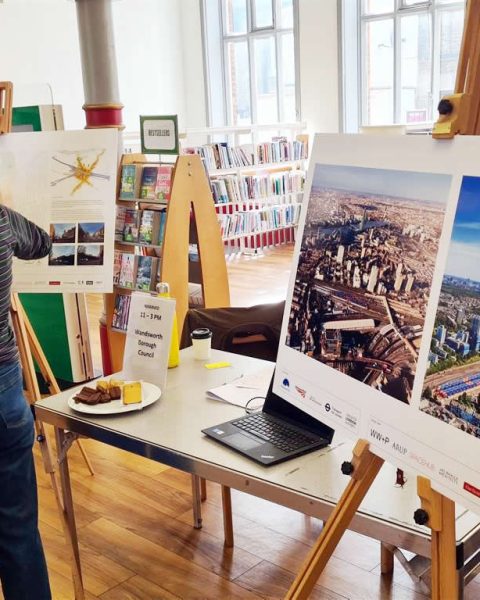>> Your chance to contribute: tell us what your think on Clapham Junction station redevelopment
Author: Cyril Richert
According to Building Design, CABE (Commission on Architecture and the Built Environment, the government’s advisor on architecture and the urban environment which took over from the Royal Fine Art Commission in 1999) might become another victim of the government’s budget cuts.
The government’s body has to be consulted over significant planning applications. But they could face difficulties to do so, given the Coalition’s plans for decentralisation of responsibility for quality of design and the cuts in funding for CABE ; as a consequence, they face tough review in the way they finance their operations, and they even consider the possibility of charging developers for design review.
The article of http://www.bdonline.co.uk says:
“The news coincided with growing evidence that planning rules and regulations will be rolled back by the coalition, including the need for planning permission on housing schemes overwhelmingly backed by the public.
Against the backdrop of a so-called “bonfire of the quangos” and ahead of this autumn’s Comprehensive Spending Review, Cabe has been asked by the Treasury to justify all its functions and examine whether the cost of these to the public purse can be reduced or eliminated.
Discussions are being held on whether design review – seen as one of Cabe’s biggest achievements since being founded in 1999 – could be funded through a “subscription” fee paid by local authorities or even by developers themselves.
This has raised doubts over whether the review could remain objective and whether developers might decide to opt out of entirely.
“Design review is not compulsory and some developers may be more than pleased to skip it to avoid larger bills,” former architecture minister and Labour peer Alan Howarth told BD.
[…] On Tuesday, housing minister Grant Shapps gave more details of the localism agenda including plans to create new Local Housing Trusts, which would develop housing largely outside the planning system and would keep profits for use by the local community.
He said: “LHTs will have to show that they have the overwhelming backing from people living in the area and they will need to meet some basic planning criteria to make their proposals sound.
“But essentially I want communities to have the freedom to decide on the type and quality of housing without external restrictions imposed by a centralised planning system.”“

















CABE has from the outside been an animal of very mixed and doubtful benefit indeed.
The insertion of a futher layer of bureaucratic burden automatically means additional cost to the process of making places, but is the additional cost worthwhile? It is disingenious to assert that the additional cost is something that the country, local authorities or developers can afford, especially during the long predicted reverse to the economic profligacy of the failed recent administration.
Some will argue that the cost does not matter. I say it does, but one moves on to the question- has the existence of CABE made for better places? If it has then the question is not does CABE have to remain- but can the same job be done better by other means, and cheaper?
CABE was for instance quite a supporter of tall buildings, often in the face of local objection.
One of the principle failings of CABE has been the centralising effect of such a body. A tick box approach to design has emerged without actually making buildings better of more appropriate for their location, or necessarily more acceptable to a local population. A frightening sameness of towns has accelerated during the “reign” of CABE’s style police. The blanket application of the required “acceptable” features and materials hardly encourages continuance of local traditions of English architecture.
The requirement for a design statement with practically every planning application (or should I say panning application?)has added dramatically to the cost. However it is doubtful if many read them and it’s pretty certain that planning committee councillors and rent a mob objectors don’t judging from the frivoulous, inaccurate and often insulting comments read and heard. The requirement in itself ignores the way in which most experienced architects intuitively design buildings.
The design review has been undertaken by persons sometimes but not always qualified or experienced in the design and construction of buildings that have been built for real clients. The client does not get a look in.
The process of the design review is essentially one made behind closed doors without the architects or clients having real opportunity to discuss the design approach. It’s obvious from reading design reviews that many are extremely superficial.
The cost of running CABE is of course substantial. Some of the people there may be good, but if they are good maybe they should get out there and design some good buildings themselves rather than just telling others how to do it. Some of those prowling their corridors already have big pensions from government departments and now have the added benefit of nice consultancy fees, when their private sector colleagues are struggling to get schemes to work.
The whole process, not just CABE, needs total review. There are too many “experts” around, many of whom are not experts at all. Pips need to squeak!
David> Regarding your last sentence, just wondering if your were siding beside Labour MPs (Tom Watson especially) who commented on Mr Gove further cuts on the BSF program 😀
http://news.bbc.co.uk/1/hi/education/10549400.stm
I am sure Mr Gove is a very nice guy, with a difficult job to do after Watson’s party left their mess.
Incidentally is CJAG taking an interest in Paris where at La Defense they have just approved three enormously tall buildings? I know that La Defense is not exactly Paradis but are our French neighbours imitating London?
We haven’t been discussing that within the group.
However I can give my personal opinion on that. First to compare La Défense with something similar in London it would be Canary Wharf. It is a big cluster of tall buildings (some say a little Manhattan) and therefore not completely at odd with the surrounding.
I haven’t see the plan in detail. But I just remember a few other facts: the Signal tower (quite a huge development too) that was promoted by the architect Jean Nouvel has been cancelled apparently, due to the economic forecast (?); therefore the effect of the new enormous development is still to be assessed.
The organisation promoting the development of La Défense (EPAD) is highly politically orientated and well known for recent outcries with the pressure to put Sarkozy’s 21 year old son at its head or the current chair from Joëlle Ceccaldi-Raynaud (also well known for being condemned by justice decisions on defamation affairs) who had open disputes with Jean Nouvel:
http://www.monputeaux.com/2010/03/pas-de-tour-signal-jean-nouvel-abandonne.html
She was claiming to be against 300m towers in La Défense (26 Feb 2010), but then approved the Hermitage Plaza from Norman Foster (323 m) putting into question her real motivations.
The tallest building in La Défense is currently Tour Total Fina Elf (187 m).